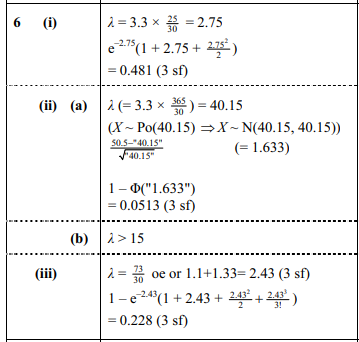Question
The battery in Sue’s phone runs out at random moments. Over a long period, she has found that the battery runs out, on average, 3.3 times in a 30-day period.
(i) Find the probability that the battery runs out fewer than 3 times in a 25-day period. [3]
(ii) (a) Use an approximating distribution to find the probability that the battery runs out more than 50 times in a year (365 days). [4]
(b) Justify the approximating distribution used in part (ii) (a). [1]
(iii) Independently of her phone battery, Sue’s computer battery also runs out at random moments. On average, it runs out twice in a 15-day period. Find the probability that the total number of times that her phone battery and her computer battery run out in a 10-day period is at least 4. [3]
Answer/Explanation
Ans:
